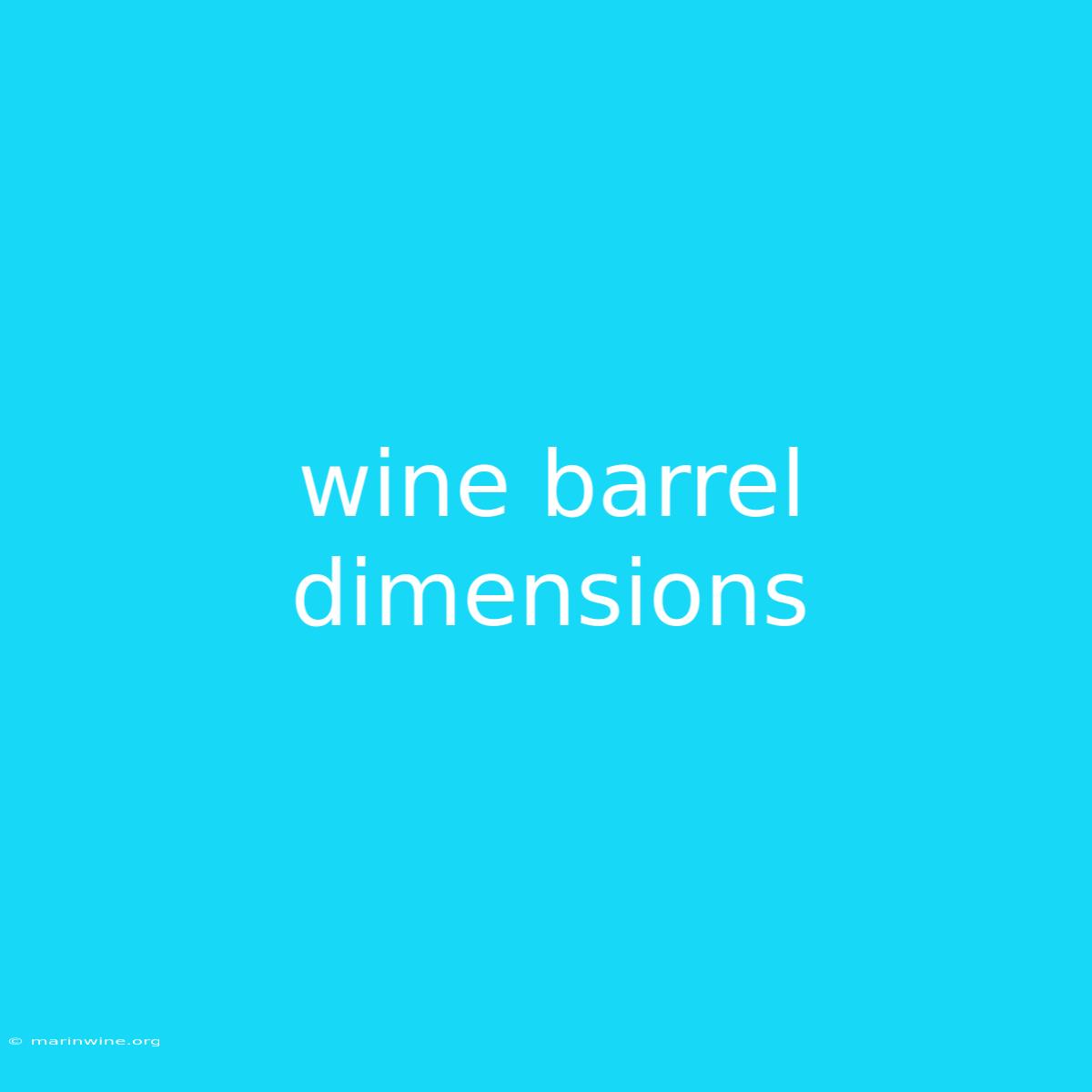Unveiling the Mysteries of Wine Barrel Dimensions: A Comprehensive Guide
Have you ever wondered about the secrets behind those iconic wine barrels? They're more than just containers – their specific dimensions play a crucial role in shaping the character of the wine they hold. This guide explores the fascinating world of wine barrel dimensions and how they influence the final product.
Why This Matters:
This article delves into the key aspects of wine barrel dimensions, offering a comprehensive overview of standard sizes, materials, and the impact of these factors on wine production. Understanding these dimensions is essential for wine enthusiasts, producers, and anyone curious about the intricacies of winemaking.
Key Takeaways of Wine Barrel Dimensions:
| Feature | Description |
|---|---|
| Standard Sizes | Bordeaux: 225 liters; Burgundy: 228 liters; American: 200-240 liters |
| Materials | Oak, Chestnut, Acacia, other woods |
| Impact on Wine | Influences aromas, tannins, aging potential, and overall flavor profile |
Wine Barrel Dimensions: A Journey of Flavor
Standard Sizes:
Wine barrels come in various sizes, each with its own unique impact on the wine. The most common sizes are:
- Bordeaux: With a capacity of 225 liters, these barrels are prevalent in Bordeaux, France, and are often associated with Cabernet Sauvignon, Merlot, and other red varietals.
- Burgundy: These barrels hold 228 liters and are widely used in the Burgundy region, primarily for Pinot Noir and Chardonnay.
- American: American oak barrels typically range from 200 to 240 liters, offering a more pronounced toasted flavor profile.
Materials:
The choice of wood plays a significant role in the wine's character. Oak is the most common material, imparting aromas of vanilla, spice, and toast. Other materials include chestnut, acacia, and even cherry, each contributing unique nuances to the final wine.
Impact on Wine:
Wine barrels influence the wine's characteristics in several ways:
- Aromas: The wood releases aromatic compounds, influencing the wine's bouquet.
- Tannins: The tannins from the wood interact with the wine's tannins, contributing to its structure and complexity.
- Aging Potential: The porosity of the wood allows for micro-oxygenation, promoting aging and complexity.
- Flavor Profile: The type of wood, its toasting level, and the length of time the wine spends in the barrel all influence the final flavor profile.
The Connection Between Wood and Wine:
Understanding the relationship between wood and wine is crucial for appreciating the impact of barrel dimensions. The toasting level of the wood, for example, directly influences the aromas and flavors imparted to the wine. A light toast will contribute subtle vanilla notes, while a heavy toast yields more pronounced smoky and caramel flavors.
Further Analysis:
Barrel Size:
Smaller barrels, like the Bordeaux and Burgundy, promote a more intense interaction between the wine and wood. This leads to a more concentrated flavor and tannin structure. Larger barrels, such as those found in America, result in a softer, more nuanced wine with lower tannins.
Barrel Type:
The type of oak used can significantly affect the wine's aromas. French oak, for example, is known for its subtle vanilla and spice notes, while American oak tends to contribute more pronounced flavors of coconut and vanilla.
FAQ for Wine Barrel Dimensions:
Q: What is the optimal barrel size for a specific wine? A: The choice of barrel size depends on the grape variety, wine style, and desired flavor profile.
Q: How does toasting affect the wine? A: Toasting imparts flavor and aromas to the wine. The level of toasting determines the intensity of these flavors.
Q: What are the benefits of aging wine in a barrel? **A: **Barrel aging allows for micro-oxygenation, contributing to the wine's complexity, color, and overall balance.
Q: Can I make my own wine barrels at home? A: While making wine barrels at home is possible, it's a complex and time-consuming process.
Q: Are wine barrels reusable? A: Yes, wine barrels can be reused multiple times. However, with each use, the wood becomes less porous and the impact on the wine diminishes.
Tips of Wine Barrel Dimensions:
- Consider the grape variety: Different grape varieties benefit from specific barrel sizes and wood types.
- Experiment with toasting levels: Experiment with different toasting levels to discover the flavor profile you prefer.
- Explore different wood types: Try using different woods to add unique aromas and flavors to your wine.
- Pay attention to the length of time in the barrel: The longer the wine stays in the barrel, the more intense the flavors and aromas will become.
- Consider using smaller barrels for more concentrated wines: If you're aiming for a robust, intense wine, consider using a smaller barrel.
Summary by Wine Barrel Dimensions:
This article has explored the fascinating world of wine barrel dimensions, highlighting their influence on the final product. From the standard sizes to the impact of materials and toasting, each aspect plays a role in shaping the aromas, flavors, and structure of a wine. Understanding these dimensions is essential for anyone seeking to deepen their appreciation for the complexities of winemaking.
Closing Message:
The next time you enjoy a glass of wine, take a moment to appreciate the intricate journey it has taken, from the vineyard to the barrel, where its final character is carefully shaped by the dimensions of its vessel.

